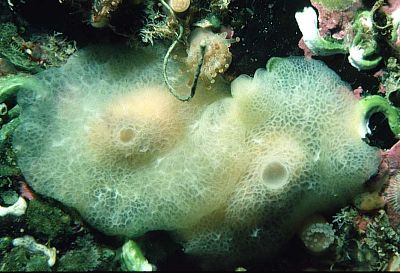
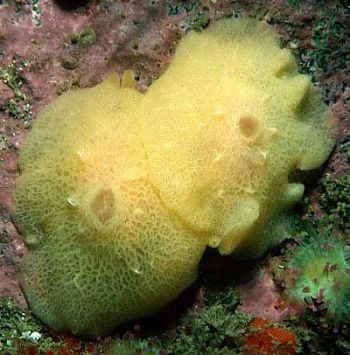
Berthella plumula
(Montagu, 1803)
Order: NOTASPIDEA
Superfamily: PLEUROBRANCHOIDEA
Family: Pleurobranchidae
DISTRIBUTION
Northeastern Atlantic from Norway to the Mediterranean Sea.
PHOTO
St. Kilda, Scotland, July, 1984, August 1985. Photos: Bernard Picton
The thin, transparent shell is internal. It is about half the body length, whicih may reach about 60mm. Stellate calcareous spicules are present in the skin. In colour it is pale lemon-yellow to orange, often with net-like markings in the middle of the smooth dorsal mantle. The skin can secrete defensive sulphuric acid if attacked. This is the type species of Berthella, described in 1803 by Montagu. It is a common species around the British Isles and extending from Norway to the Mediterranean. It is normally found beneath rocks on the lower shore but I have seen it frequently at St. Kilda on the west coast of Scotland down to depths of 30m. on steep rock faces. It seems to feed on the sponge Oscarella lobularis (actually the Oscarella in the British Isles is probably not named and distinct from Mediterranean O. lobularis). The appearance of Berthella seems to be providing camouflage on Oscarella, with a central transparent patch mimicking an oscule of the sponge and the reticulate pattern looking similar to lobules of the sponge. Thompson (1984, 1988) suggests that Berthella plumula may feed on tunicates but there have been no published observations to support this idea.
Reference:
• Thompson, T.E. (1988) Molluscs: Benthic Opisthobranchs (Mollusca: Gastropoda). Synopses of the British Fauna (New Series). No. 8. 2nd Edition. E.J.Brill/W. Backhuys: Leiden. 1-356.
Picton, B.E., 2002 (January 3) Berthella plumula (Montagu, 1803). [In] Sea Slug Forum. Australian Museum, Sydney. Available from http://www.seaslugforum.net/find/bertplum
Related messages
Re: Berthella sp ? from Mediterranean
April 20, 2005
From: Juan Lucas Cervera
Dear Sylvie and Bill,
This animal [message #13500] is Berthella plumula.
Regards.
Lucas.
lucas.cervera@uca.es
Cervera, J.L., 2005 (Apr 20) Re: Berthella sp ? from Mediterranean. [Message in] Sea Slug Forum. Australian Museum, Sydney. Available from http://www.seaslugforum.net/find/13582Thanks Lucas,
Now that you have identified it, I can see the characteristic reticulate pattern this species has on the mantle and the darker central spot..
Best wishes,
Bill Rudman
Berthella sp ? from Mediterranean
April 18, 2005
From: Sylvie Grall
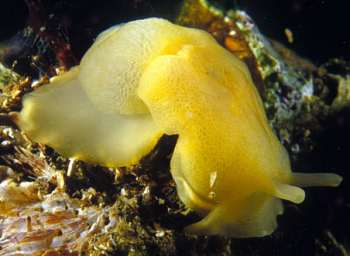
Dear Bill,
I have doubts about this yellow Berthella I found in the Etang de Thau (april 2004). Could it be Berthellina citrina? What is the difference between Berthella and Berthellina?
Locality: Etang de Thau. France. Mediterranean. Depth: 5 m. Length: 30 mm. 2 April 2005. Pillars. Photographer: Sylvie Grall
Thank you for your help.
Sylvie.
sgrall@compuserve.com
Grall, S., 2005 (Apr 18) Berthella sp ? from Mediterranean. [Message in] Sea Slug Forum. Australian Museum, Sydney. Available from http://www.seaslugforum.net/find/13500Dear Sylvie,
I am afraid this could be one of a number of yellowish pleurobranchs known from Europe. There is quite a correspondence on the Forum about this [see Lucas Cervera's message #8145 for an idea of the problem]. The only simple difference is the size of the fragile internal shell - large in Berthella, small in Berthellina - but that is not obvious in photos or live animals. So unfortunately in this case I have to admit total defeat
Best wishes,
Bill Rudman
Berthella plumula from the British Isles
January 5, 2002
From: Bernard Picton


Hi Bill,
Checking through the Forum today I see that you don't have much on Berthella plumula, so here are some photos and information. It is the type species of Berthella, described in 1803 by Montagu. It is a common species around the British Isles and extending from Norway to the Mediterranean. It is normally found beneath rocks on the lower shore but I have seen it frequently at St. Kilda on the west coast of Scotland down to depths of 30m. on steep rock faces. It seems to feed on the sponge Oscarella lobularis and the appearance of Berthella seems to be providing camouflage on Oscarella, with a central transparent patch mimicking an oscule of the sponge and the reticulate pattern looking similar to lobules of the sponge. I have illustrated this is in a separate message
Photos are from St. Kilda, Scotland, July, 1984 and August 1985.
Bernard Picton
bernard.picton.um@nics.gov.uk
Picton, B.E., 2002 (Jan 5) Berthella plumula from the British Isles. [Message in] Sea Slug Forum. Australian Museum, Sydney. Available from http://www.seaslugforum.net/find/5893Thanks Bernard,
Bill Rudman
Food of Berthella plumula
January 5, 2002
From: Bernard Picton
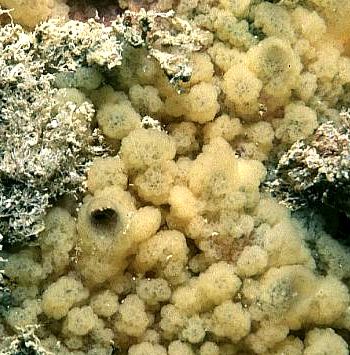
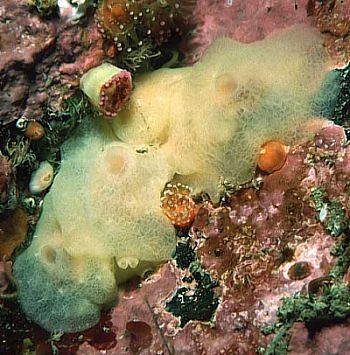
Hi Bill,
To accompany my photos of Berthella plumula here us some feeding information.
It seems to feed on the sponge we call Oscarella lobularis (actually the Oscarella in the British Isles is probably a new species, distinct from the Mediterranean O. lobularis). The
appearance of Berthella seems to be providing camouflage on Oscarella, with a central transparent patch mimicking an oscule of the sponge and the
reticulate pattern looking similar to lobules of the sponge. Thompson (1984)
suggests that Berthella plumula may feed on tunicates so I was interested to
see on the Forum that Berthella ocellata feeds on Plakina, as this is quite closely related to Oscarella.
The upper photo is of the sponge Oscarella lobularis - Blasket Is., Co. Kerry. The lower photo is of a group of Berthella from St. Kilda, Scotland, July, 1984.
Bernard
bernard.picton.um@nics.gov.uk
Picton, B.E., 2002 (Jan 5) Food of Berthella plumula. [Message in] Sea Slug Forum. Australian Museum, Sydney. Available from http://www.seaslugforum.net/find/5894Thanks Bernard,
Bill Rudman
Berthella plumula from Scotland
December 13, 2001
From: Jim Anderson
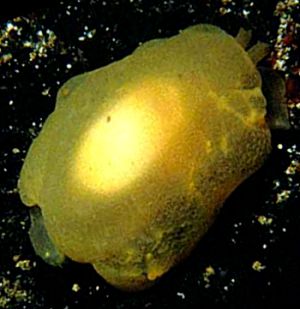
Dear Dr. Rudman,
Here is Berthella plumula from Scotland.
Data: Scourie, Sutherland, Scotland. June 1989. An 18mm long specimen, in 6 metres.
Kind regards,
Jim A
jander4454@aol.com
Anderson, J., 2001 (Dec 13) Berthella plumula from Scotland. [Message in] Sea Slug Forum. Australian Museum, Sydney. Available from http://www.seaslugforum.net/find/5733Thanks Jim,
Bill Rudman
